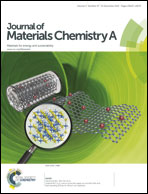Trimodal hierarchical carbide-derived carbon monoliths from steam- and CO2-activated wood templates for high rate lithium sulfur batteries†
Abstract
Hierarchically structured biomorphic carbide-derived carbon (CDC) materials are obtained by applying a combined activation- and CDC approach on abundantly available, renewable and cheap raw materials. For the synthesis of these materials we mimic nature by using wood structures as templates which are already optimized for mass transport during their long-term evolutional process. The impregnation of steam- or carbon dioxide-pre-activated wood templates with a polycarbosilane precursor and the subsequent halogen treatment yields a hierarchical material that exhibits longitudinally orientated macropores from the wood structure as well as well-defined and narrowly distributed micro- and meso-pores derived from the activation and CDC approach. These materials offer specific surface areas up to 1750 m2 g−1, micro-/meso-pore volumes up to 1.0 cm3 g−1 and macropore volumes of 1.2 cm3 g−1. This sophisticated hierarchical pore system ensures both efficient mass transfer and high specific surface area, ideal for mass transport limited applications, such as the lithium sulfur battery. Testing steam activated wood-CDCs as cathode materials for Li–S batteries reveals excellent performance, especially a highly stable discharge capacity and sulfur utilization. Stable capacities of over 580 mA h gsulfur−1 at current densities exceeding 20 mA cm−2 (2C) are possible using only very low amounts of electrolyte of 6.8 μL mgsulfur−1.


 Please wait while we load your content...
Please wait while we load your content...